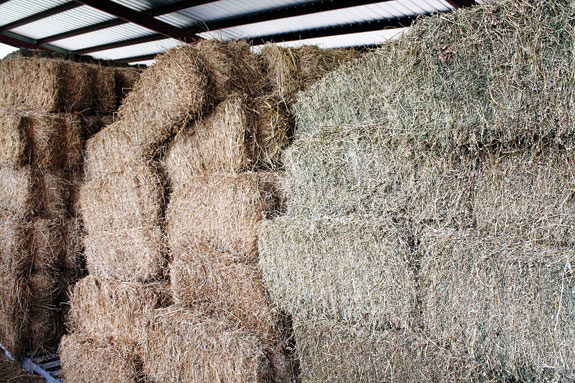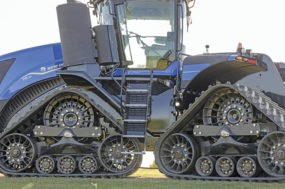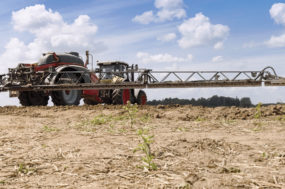With the advent of large round balers, large square balers and hay wrappers, producers now have a multitude of choices on how to store their hay, but the small square bale still has a strong place in the marketplace.
For horses, show animals and owners of small numbers of animals, it’s hard to beat the convenience of packaging hay in a form that can be handled by one person.
The primary markets for small square bales are for high-quality hay. Bale size is usually not more than 40 to 50 pounds in order to make it easy to handle.
Appearance is important in this market, so protecting the hay from sun bleaching is important as well.
Storing these bales presents a different set of challenges than storing large round bales. We not only want to maintain quality, but appearance is of utmost importance in these markets.
While an open-sided barn is excellent for maintaining quality in large round bales and also provides maximum ventilation, small square bales headed for premium markets are better stored in buildings with sidewalls. Sidewalls protect the bales from sun exposure but also create some challenges of their own.
Building cost
The first challenge is cost. An enclosed building may cost twice as much as an open-sided building. The loads, due to wind, are much higher in a closed building and they may need to be made with larger structural members.
In addition, the cost of siding itself is significant. The resulting improvement in quality and appearance may be well worth the cost, but you need to keep in mind that you have to recover the extra cost of a more expensive building in the price of the hay.
In order to make a good decision, you really need to know what it costs you each year to own a barn and how many bales you can store in that barn.
That can vary considerably depending on size and construction, but a typical price might be $0.30 per bale for an open-sided barn with a dirt floor, while an enclosed barn with a concrete floor might be more like $0.80 per bale.
Again, you need to know what your figures are rather than using these typical figures so you can decide whether or not the added cost is worth it to your market.
Ventilation
Another challenge is ventilation. Remember that if you put 100 tons of hay in a barn at 16 percent moisture, it will naturally dry down to an equilibrium moisture content of around 13 percent over the next few weeks.
That amounts to three tons or 719 gallons of water being released into the air around the hay, and without adequate ventilation, that moisture can condense on the interior building surfaces and cause structural damage as well as possibly dripping back onto the hay. A general recommendation for ventilation is to provide the larger of the following:
1. a six-inch continuous ridge vent
2. two inches per 10 feet of barn width
For a 50-feet-wide by 100-feet- long barn, that would be 10 inches of continuous ridge vent or 83 square feet of opening in gable and ridge ventilators.
These openings allow the warm, moist air to leave, but in order for them to function, you need to provide an equal area of vents near the bottom of the barn to allow cooler, drier air to enter.
This can be provided by leaving the bottom six inches to one foot of the walls open. (This opening can be covered with wire to help keep out vermin.) It is also important to allow unobstructed pathways for that ventilation air to travel from the inlets to the exit vents.
Flooring
Yet another issue that must be considered (really whether you are storing large or small bales) is what kind of flooring to use.
It is always a challenge to keep that bottom layer of hay from getting wet and deteriorating. The most important thing to ensure when you are building a barn is that the barn floor is elevated and well- drained so that the soil under the barn stays as dry as possible.
It is virtually impossible to not have some spoilage in the hay on most flooring systems unless you have a raised floor with ventilation under it.
Hay lofts worked very well because of the good ventilation under the floors, but it was a tough job getting the hay up and down from the loft. Probably the best flooring material for a hay barn would be concrete with a vapor barrier underneath it.
The problem with concrete is: It is very expensive. For premium hay, this extra cost may be justified but, again, you have to recover that cost through the price of the hay sold.
Coarse gravel helps to allow some ventilation under the hay, but eventually, the cracks will fill up with dirt and hay particles.
Pallets or similar devices can be placed under the hay bales. This provides good ventilation but the pallets must be moved as hay is moved in and out or must be strong enough to stand up under the weight of a tractor.
One other strategy is to stack the bottom level of hay bales on their edge. This improves ventilation, and in a worst-case scenario, if the bottom couple of inches are ruined by moisture, at least the twine is not destroyed, making it possible to handle the hay.
Small square bales will probably always be in demand. Storing them so they retain their initial quality and market appeal can be accomplished, but there is a cost associated with that high quality and that cost must be understood and accounted for if your hay enterprise is going to have the bright future we all hope for. FG
References omitted due to space but available upon request. Click here to email an editor.
PHOTO
Maintaining quality and appearance of small square bales is of utmost importance in the horse and small animal market. Photo courtesy of John Worley.











